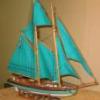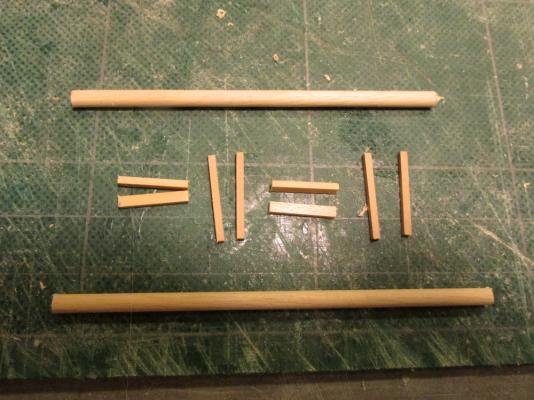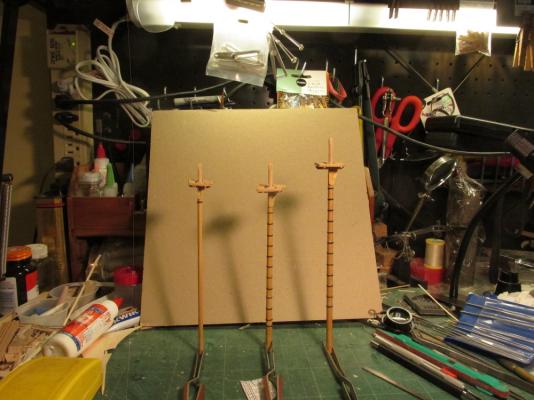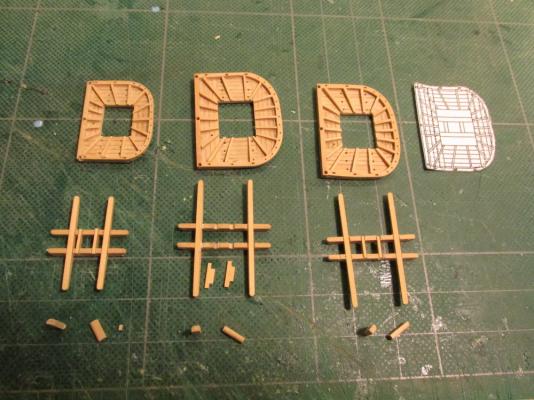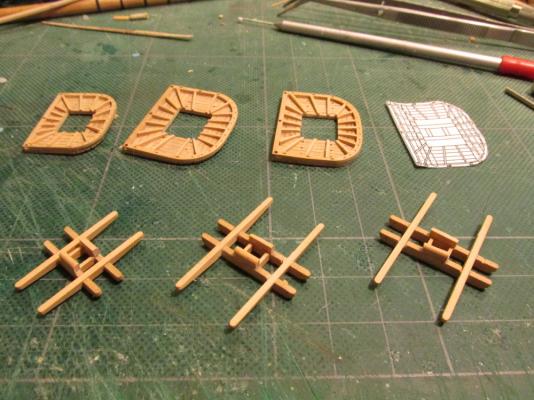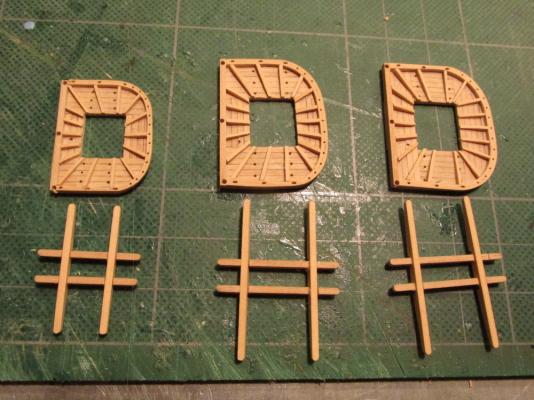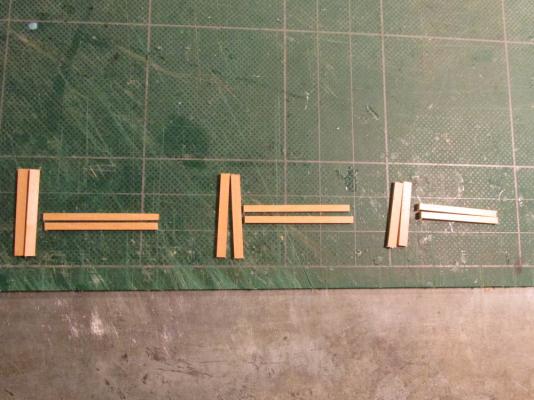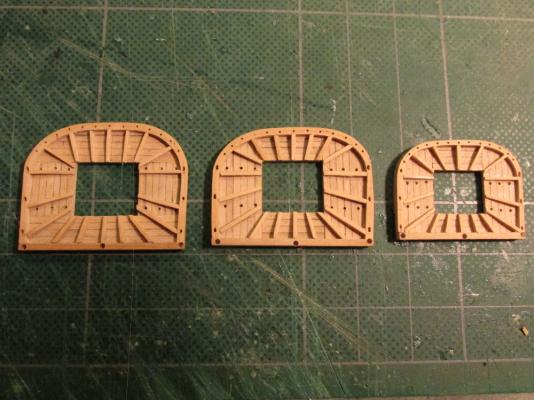-
Posts
2,625 -
Joined
-
Last visited
Content Type
Profiles
Forums
Gallery
Events
Everything posted by JSGerson
-
Another comment on the ship's boat - I have seen logs/practicums (can't remember which) on how to make this style of construction. One of the tips was not to initially glue the bottom piece on. This way it makes it easier to file, sand, or drummel the interior because now it's open at the top and bottom. Once the insides are finished, the bottom piece is then added and finished off. I know it's a bit late for you at this point but maybe it will help someone else.
- 264 replies
-
- rattlesnake
- model shipways
-
(and 1 more)
Tagged with:
-
That is the plan. Do as much as I can off ship where it's relatively easier.
- 974 replies
-
- rattlesnake
- mamoli
-
(and 1 more)
Tagged with:
-
I heard the same thing about the ebony wood. I guess it was a blessing in disguise I didn't use it. And you are right, those trestletrees were tricky and delicate. I broke a few pieces it its construction. The masts will be installed piece by piece as the rigging progresses...at least that the plan. I still have to create the bowsprit parts not to mention the all the yards. So I got a bit more work to complete before full fledged rigging commences.
- 974 replies
-
- rattlesnake
- mamoli
-
(and 1 more)
Tagged with:
-
Having never built a wooden 3 masted ship before, I really put a lot on my plate especially because I was "coloring" the model by using different woods. No chance to cover errors with wood filler and paint. The Practicum called for the use of ebony in many places but at the time I purchased the wood package from HobbyMills, Jeff Hayes its owner, didn't have any. So where ever you see black, it's painted because it should have been ebony wood. As near as I can tell, it still looks OK.
- 974 replies
-
- rattlesnake
- mamoli
-
(and 1 more)
Tagged with:
-
The image below shows the dry fit of the masts. The mast caps will be painted black because I didn’t have any ebony wood. All of the blocks, rings, etc. will be installed before the first masts are installed into the hull.
- 974 replies
-
- rattlesnake
- mamoli
-
(and 1 more)
Tagged with:
-
According to the Practicum, Mr. Hunt constructed each mast assembly as a whole before moving on to the next one. I elected to work on all the masts at once working my up. The instructions give you the choice of using stock square boxwood or the dowels to create the remaining mast sections. I would have preferred using the boxwood as I did for the spares stored under the ship’s boat, but I did not have much left of the sizes I needed or the size called was not part of the wood package [3/16” square boxwood for the mizzen mast], so I used the dowels. I found myself actually squaring the dowels to get the proper widths along the length of the masts based on Hahn’s plans and then rounding them out again. Unfortunately my lathe is a bit too heavy for the delicate turning required -it was all done by hand. The topmast trestletrees were constructed based directly on Hahn’s plans, not the dimensions the Practicum gave. I found that the plans of Mamoli, MS, and the Practicum were not consistent in their measurements of the trestletree, so I fell back to Harold Hahn.
- 974 replies
-
- rattlesnake
- mamoli
-
(and 1 more)
Tagged with:
-
I am assuming that you will be painting your creation according to the MS instructions as well. That gives you an extra advantage over those of using natural wood. You can cover up most of your mistakes. You can use wood filler to fill in cracks between planks, and minor low areas, and then paint over the whole thing and nobody would be able to tell if and where you might have messed up a bit; so don't fret too much about minor consistences I jumped in with no experience in planking at all and used natural wood so I couldn't hide my mistakes, and make them I did. It could have come out worse but it could have come out better had I known what I was doing. Take your time, and don't forget to bevel your planks on one edge otherwise each plank will appear to have a narrow space between them especially where the hull curves outward.
- 131 replies
-
- rattlesnake
- model shipways
-
(and 1 more)
Tagged with:
-
Welcome aboard, glad to have another spectator, but be prepared for a long read. I work slow. That's because I usual don't know what I'm doing and have to mentally figure it out. And I make mistakes...lots of them. If I am not making the same mistake twice, I'm usually trying out a new one 8-). If you are going to make the Rattlesnake, I strongly suggest getting Robert Hunt's Practicum. It may not be perfect (as I had documented), but I could not have gotten as far as I have without it.
- 974 replies
-
- rattlesnake
- mamoli
-
(and 1 more)
Tagged with:
-
Be careful with that plastic miter-box. Over time it has a tendency to be cut through by the steel blades used to make the cuts. I use a metal miter-box which looks very similar but without the peg holes. It has lasted many years of constant use and still going strong.
- 131 replies
-
- rattlesnake
- model shipways
-
(and 1 more)
Tagged with:
-
dgbot - I went looking for Bob Filipowski's build log on the English Long Boat as you stated above. I couldn't find it. I searched under his name, checked the member's list, and search all the long boat logs I found - no luck. Can you point me in the right direction?
- 131 replies
-
- rattlesnake
- model shipways
-
(and 1 more)
Tagged with:
-
There was basically one method I found for creating the lettering in the various logs I looked at - transfer lettering; the letters are rubbed on from a sheet. The problem I had was the area I needed to place the ship's name was too narrow. So I created my own method which I described in my log at comment 337. In effect, the name was placed on a plaque like the one on the USF Constitution and then glued into place on the transom.
- 131 replies
-
- rattlesnake
- model shipways
-
(and 1 more)
Tagged with:
-
You will find that that you will make mistakes, things break, the kit will have omissions, whatever. It would be good idea to invest in some basic wood stock as a reserve. Your local hobby store will usually have basswood which I believe is the basic wood stock for the MS kit. My Mamoli boat is built with a fancier wood package I purchased from HobbyMills which means I have/need extra boxwood, holly, and swiss pear wood, Jeff Hayes, who runs this HobbyMills, will bend over backwards to get what you need, just ask anyone who has dealt with him. If you are in a real pinch and must complete the waterways NOW, then yes you can skip areas that are unseen. I personally would try to avoid that because you would know you skipped part of the build. It will bother you and haunt you in your dreams (maybe) even though the casual observer won't even know it even exists or it's missing. Remember, its a hobby, not a race. Time is on your side. I've been working on my boat for over four years and have just reached the masts. Enjoy!
- 131 replies
-
- rattlesnake
- model shipways
-
(and 1 more)
Tagged with:
-
Waterboard - I assume you mean "waterways" (at least that's what my instructions for the Mamoli kit called it), the trapezoidal cross section strip of wood at the junction of the deck and bulwarks. The Practicum I was following indicated it went from the tip of the bow all the way back to the cabins under the quarter deck.
- 131 replies
-
- rattlesnake
- model shipways
-
(and 1 more)
Tagged with:
-
Some boats look good either way: painted or with natural woods; others demand to be painted e.g. USF Constitution (at least in my humble opinion).
- 131 replies
-
- rattlesnake
- model shipways
-
(and 1 more)
Tagged with:
-
Looks real good. Just remember, they are filler blocks. Any imperfections, gaps, etc. with the bulkheads will be covered up by planking, so don't sweat too much about the small stuff...just a little bit. 8-)
- 131 replies
-
- rattlesnake
- model shipways
-
(and 1 more)
Tagged with:
-
Just found your log and I look forward to following your progress. My Rattlesnake is my first POB build so if you look at my log, be aware I've made numerous miss-steps along the way, most of which I've documented. That may come in handy so you don't do the same. Have patience, do research, and most of all, have fun.
- 131 replies
-
- rattlesnake
- model shipways
-
(and 1 more)
Tagged with:
-
The platforms were then glued into position on the trestletree/crosstree structures. The images below show the fighting tops on their mast as a dry fit. They won’t be glued into place until all the components of the masts have been made.
- 974 replies
-
- rattlesnake
- mamoli
-
(and 1 more)
Tagged with:
-
The chocks are the little cross pieces inside the trestle tree. According to the Practicum, the aft piece is glued in place butted against the aft crosstree. According to everyone else, it a bit forward of the aft crosstree. The chocks were made from 1/32” x 3/32” boxwood in the shape of a “T” with a fat stem. A set of notches were cut with an X-Acto knife for the aft chock first based on Hahn’s plans. With that chock set in place as a dry fit, the assembly was then slipped over its mast to determine where the forward chock was to be placed. The forward chock notches were then cut. Additionally the Practicum called for bolsters to be made from 1/32” square boxwood a little later on. I saw no reason why they couldn’t be set into place at this point. Unfortunately, I had run out of 1/32” square boxwood, so I used 1/16 x 3/32”. The bolsters have a quarter circle cross section to allow lines to drape over them without damaging them.
- 974 replies
-
- rattlesnake
- mamoli
-
(and 1 more)
Tagged with:
-
Once dry fitted and trimmed, the trestletrees and the crosstrees were mated and glued together using WeldBond. I chose the white glue over the CA glue because it gave me wiggle room to make sure everything was square before it set.
- 974 replies
-
- rattlesnake
- mamoli
-
(and 1 more)
Tagged with:
-
These were in turn notched using the Byrnes Saw and the sides angled using a disc sander for their clean cuts and consistency.
- 974 replies
-
- rattlesnake
- mamoli
-
(and 1 more)
Tagged with:
-
I finally got to cut the boxwood pieces for the trestletrees (1/8” x 1/16”) and its crosstrees (3/16” x 1/16”).
- 974 replies
-
- rattlesnake
- mamoli
-
(and 1 more)
Tagged with:
-
- 974 replies
-
- rattlesnake
- mamoli
-
(and 1 more)
Tagged with:
-
Steve - When I started this build soooo long ago I knew nothing except how to follow directions. I had no books and few ship building skills. Now I have so many directions it gets confusing, as I have noted above numerous times. Actually I have all of the books you mentioned plus another 20 or so. I have spent a fortune in books alone. My latest one is The Fully Framed Model, Rigging a Sixth Rate Sloop of 1767 - 1780 Vol. IV by David Antscherl which excellent. I wish I had known about and read his first three volumes when building the Rattlesnake hull. That's one of the reasons I go so slow, I'm always pouring through my reference library. I can't stress enough the importance of a build log. I was afraid, like you, to write a log knowing there were craftsmen out there who had skills way beyond mine. I was pushed and reluctantly started to write. It was the best thing I could have done. Just organizing my thoughts to tap them out on the keyboard helped me understand what I was doing, plus the feedback was invaluable. Jon
- 974 replies
-
- rattlesnake
- mamoli
-
(and 1 more)
Tagged with:
-
Chuck, I welcome another Rattler. You will find I have documented a lot of errors. Just don't follow too close and make the same ones! 8-)
- 974 replies
-
- rattlesnake
- mamoli
-
(and 1 more)
Tagged with:
About us
Modelshipworld - Advancing Ship Modeling through Research
SSL Secured
Your security is important for us so this Website is SSL-Secured
NRG Mailing Address
Nautical Research Guild
237 South Lincoln Street
Westmont IL, 60559-1917
Model Ship World ® and the MSW logo are Registered Trademarks, and belong to the Nautical Research Guild (United States Patent and Trademark Office: No. 6,929,264 & No. 6,929,274, registered Dec. 20, 2022)
Helpful Links
About the NRG
If you enjoy building ship models that are historically accurate as well as beautiful, then The Nautical Research Guild (NRG) is just right for you.
The Guild is a non-profit educational organization whose mission is to “Advance Ship Modeling Through Research”. We provide support to our members in their efforts to raise the quality of their model ships.
The Nautical Research Guild has published our world-renowned quarterly magazine, The Nautical Research Journal, since 1955. The pages of the Journal are full of articles by accomplished ship modelers who show you how they create those exquisite details on their models, and by maritime historians who show you the correct details to build. The Journal is available in both print and digital editions. Go to the NRG web site (www.thenrg.org) to download a complimentary digital copy of the Journal. The NRG also publishes plan sets, books and compilations of back issues of the Journal and the former Ships in Scale and Model Ship Builder magazines.


